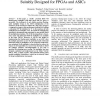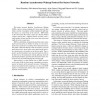305 search results - page 54 / 61 » Improving IEEE 802.11 power saving mechanism |
ICC
1997
IEEE
14 years 24 days ago
1997
IEEE
— We apply coset codes to adaptive modulation in fading channels. Adaptive modulation is a powerful technique to improve the energy efficiency and increase the data rate over a ...
CDES
2006
13 years 10 months ago
2006
In this paper, a double precision IEEE 754 floating-point multiplier with high speed and low power is presented. The bottleneck of any double precision floatingpoint multiplier des...
BROADNETS
2005
IEEE
14 years 2 months ago
2005
IEEE
— Lightweight protocols that are both bandwidth and power thrifty are desirable for sensor networks. In addition, for many sensor network applications, timeliness of data deliver...
MICRO
2008
IEEE
13 years 8 months ago
2008
IEEE
Distributed processors must balance communication and concurrency. When dividing instructions among the processors, key factors are the available concurrency, criticality of depen...
BROADNETS
2004
IEEE
14 years 10 days ago
2004
IEEE
This paper presents Random Asynchronous Wakeup (RAW), a power saving technique for sensor networks that reduces energy consumption without significantly affecting the latency or c...


